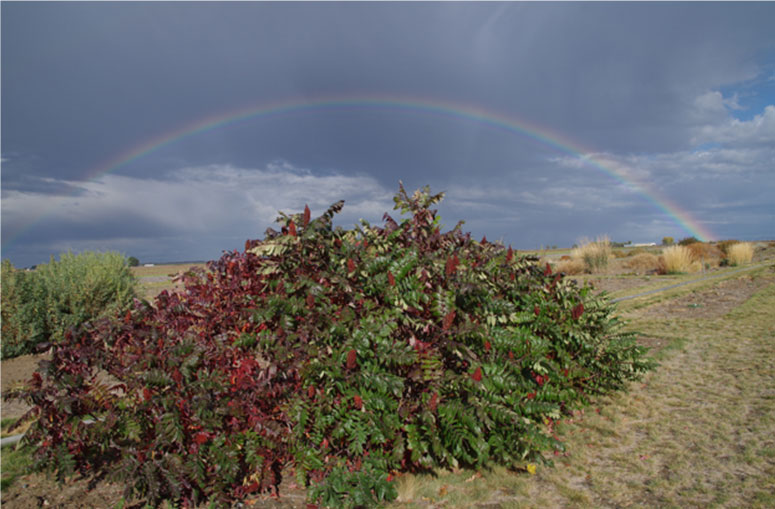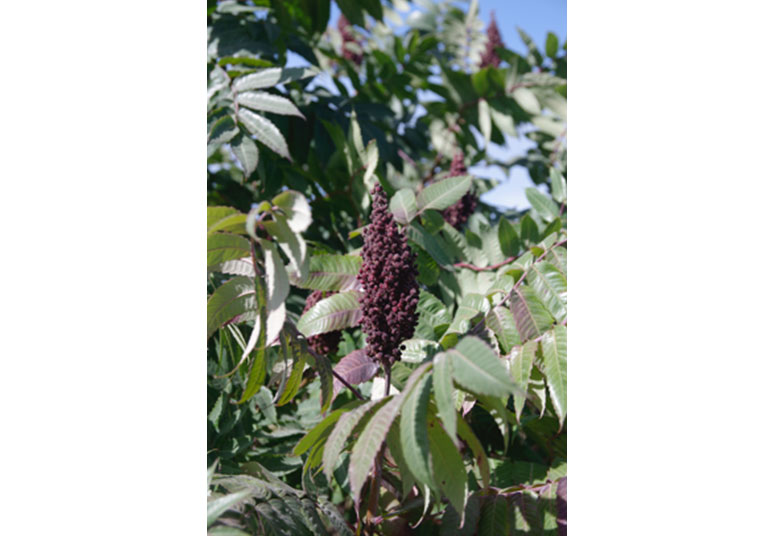Rhus Glabra in the Landscape


Karen Panter, University of Wyoming
Scientfic Name: Rhus GlabraCommon Name: Smooth Sumac
Description: Deciduous shrubs, usually with separate male and female plants (dioecious). Smooth sumac can reach 10 feet in height and as wide, and often forms large patches due to its suckering nature. Flowers are not showy but the fruits that develop in the fall are bright scarlet and very attractive. Fruits also stay on the plants well into winter months. Foliage is deeply divided into 11 to 23 leaflets that are dark green on the upper side with a whitish cast to the lower side. Foliage turns bright scarlet in fall.
Native Habitat: Smooth sumac is native to virtually all of North America. It is typically found on hills and slopes where soil drainage occurs. Smooth sumac will grow in almost any soil type, as long as it drains well. It is extremely cold hardy, as evidenced by its wide geographic range.
Cultural Requirement
Soil: Prefers deep soils that are well-drained. Tolerant to a wide range of soil types.
Moisture Tolerance: Smooth sumac is drought tolerant so avoid keeping too wet.
Sun/Shade/Preference: Full sun to part shade.
Transplanting: Easy.
Propagation: Can be divided using suckers. Seeds typically require scarification for about 60 minutes in sulfuric acid. Then either sow the seeds in the fall outdoors or provide 2 months stratification at about 40F. May also be propagated using root cuttings.
Maintenance (pruning, fertilization, deadheading, division, irrigation, etc): Remove unwanted suckers periodically. Low to moderate fertilizer and water requirements. Generally low maintenance plants aside from suckering nature.
Insect, disease, or other problems: None of major importance. Problems that have been reported on occasion include wilts, leaf spots, rusts, mites, aphids, and scales.
Landscape Value
Use in the Landscape: Very attractive shrubs especially for fall and winter color. Give them plenty of space as they will form clumps. Can be used to form informal hedges and for greatest effect, plant in masses.
Weediness/Invasive Potential: Spreads via rhizomes and often creates large colonies. This characteristic should be considered when placing this species in the landscape.
Foliage: Leaves are alternate, divided into leaflets with medium to dark green color. Fall colors are brilliant, from yellow to orange to red.
Flower: Inconspicuous and usually greenish-yellow. Plants are typically dioecious (male or female).
Timing: June, July.
Fruit: Deep red or scarlet drupe, containing one seed. Fruits are typically hairy and often mature October. Seeds are eaten by many bird species.
Form: Large shrubs but can be pruned into a small tree with a single trunk. Usually form loose, open colonies.
Texture: Medium to coarse.
Ultimate Size: 10 feet tall by 10 feet wide for smooth sumac.
Rate of Growth: Medium to fast.
Suggested Plant Partners: Sumacs require a fair amount of room, so would not suggest planting too close to other landscape plants.
Availability: Readily available from most larger nurseries, usually in containers, sometimes balled-and-burlapped.
Cultivars: The most readily available cultivar of smooth sumac is ‘Laciniata’. Another is ‘Cismontana’, reported to be smaller and more drought resistant, reaching 6 feet by 6 feet.
References:
Dirr, M.A. 1998. Manual of woody landscape plants. Stipes Publishing Company, Champaign, Illinois.
Dorn, R.D. 1992. Vascular plants of Wyoming. 2nd edition. Mountain West Publishing, Cheyenne, Wyoming.
Hartmann, H.T., D.E. Kester, F.T. Davies Jr., and R.L. Geneve. 2011. Hartmann and Kester’s plant propagation. 8th edition. Prentice Hall, Upper Saddle River, New Jersey.
Sunset Western Garden Book. 2001. Sunset Publishing Corporation, Menlo Park, California.
USDA-NRCS Plants Database. https://plants.sc.egov.usda.gov/java/. Accessed 18 October 2019.Photo courtesy of Stephen Love, University of Idaho.

